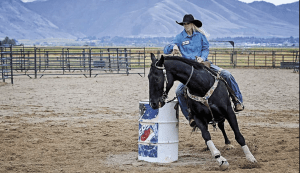Running outside, chasing your friends, playing with Legos–these are things you might remember doing as a young child. However, from the late 1700s to the mid-1800s in Britain, being paid meager wages and working for as much as sixteen-hour days with dangerous mining equipment was the norm for many young, British children. During the Industrial Revolution this was an ugly reality. Many working-class families found it necessary to have their children work alongside them in the mines. Because of their size and cooperation, and because it was easier to pay them less, these children were paid about five times less than men for the same number of hours worked, which for these young miners could be up to fourteen-hour days.1

Before the Mines and Collieries Act of 1842, children as young as four were allowed to work in the mines.2 Just imagine such young children running around a dark coal mine–it simply does not sound safe at all. These children were hired to be able to get into those hard to reach places that fully grown adults were unable to get into. During the Industrial Revolution, coal was a major source of energy, and was extremely important because it burned hotter than wood charcoal. The primary use of coal was used as a source of energy, and used to power the steam engines of factories, where many other children also worked. Because of its high demand and necessity, it helped increase jobs for the working people. Because of these factories, major industrial cities such as Birmingham, Manchester, and Liverpool, grew at a fast pace from small villages into large cities.3

In British coal mines, children typically had one of three jobs. Trappers, typically the youngest, would open and close the wooden doors–also called trap doors–to allow fresh air to flow through the mine. These trappers would sit in darkness for almost twelve hours at a time. It may seem a simple task, but if one of these little ones fell asleep, the job could become very dangerous. Other jobs were the tasks of hurrier and thruster. These jobs were usually given to older children and women. These workers had to pull and push tubs that were full of coal along the roadways, all the way to the pit bottom. The hurriers would be harnessed to the tub, and the thrusters would then help hurriers by pushing these tubs of coal. The thruster would have to push tubs of coal weighing over 600 kilograms from behind with their hands and the tops of their heads. The thrusters, mainly older girls, had to carry these baskets of dug coal, which were much too heavy for them. Because of their heavy weight, it would then cause their young, growing bodies to develop with deformities. The last typical job was the getter. This one was typically assigned to the oldest and strongest, usually grown men or strong, older teens. This job required them to work at the coal face, cutting the coal from the seam with a pickaxe. This was typically the only job where they would use a candle or safety lamp for light, as cutting the coal required it.4 Although the work at the coal mine may not seem very difficult, it was very dangerous. In one unnamed coal mine, 58 of the total 349 deaths in one year involved children thirteen years or younger.5

Those who worked in coal mines–whether below or above ground–were exposed to life-threatening working conditions that could ultimately be detrimental to their health. Children, mainly boys as young as eight, worked as breakers. Here, the coal was crushed, washed, and sorted according to size. The coal would come down a chute and along a moving belt. These breaker boys would work in what was called the picking room. Here, they would work hunched over for ten hours a day, six days a week, sorting the rock and slate from the coal with their bare hands. If their attention even drifted for a second, they could lose a finger in the machinery.6 The work also resulted in their exposure to a large amount of dust. In some cases, the dust was so dense that their vision would be obstructed. This dust would also get into their lungs, which needless to say, was terrible for their health.7 These children sometimes even had a person prodding or kicking them into obedience to make sure their attention did not stray.
These working conditions for children continued until the United Kingdom’s Parliament passed the Mines and Collieries Act of 1842. The act included a report that informed the public about how children as young as five years old were working as trappers for “twelve hours a day and two pennies a day.”8 It was not until the Children’s Employment (Mines) Report came out alongside it in 1842 that Parliament passed the act that all boys and girls under the age of ten were not allowed to work in the coal mines.9 Even after this law prevented children under fourteen from working in the mines, people still found ways around it. For example, since some regions did not have a compulsory registration of birth, someone could easily lie and claim that these boys were simply “small for their age.” Finally, with this legislation came the snowball effect of humanitarians and a larger awareness of health and safety regulations for workers, which led to the start of the end of child labor in England.10
- Children’s Employment Commission First Report of the Commissioners (Mines), (Halifax: Irish University Press, 1842), 77-81. ↵
- Encyclopedia Britannica.com, December 2012, s.v. “Anthony Ashley Cooper, 7th earl of Shaftesbury,” by Editors of Encyclopedia Britannica. ↵
- New World Encyclopedia, February 2017, s.v., “Child Labor,” by New World Encyclopedia Contributors. ↵
- Great Britain Commissioners, The Condition and Treatment of the Children employed in the Mines and Colliers of the United Kingdom Carefully compiled from the appendix to the first report of the Commissioners With copious extracts from the evidence, and illustrative engravings, (London: 1842), 19-59. ↵
- J. M. Mason, “Protection of Children,” The Westminster Review Vol. 36 (1841): 66. ↵
- Jane Humphries, “Short stature among coal-mining children: A comment,” Economic History Review 1, no. 3 (1997): 533. ↵
- Jane Humphries, “Short stature among coal-mining children: A comment,” Economic History Review 1, no. 3 (1997): 535. ↵
- Encyclopedia Britannica.com, December 2012, s.v. “Anthony Ashley Cooper, 7th earl of Shaftesbury,” by Editors of Encyclopedia Britannica. ↵
- “Early Factory Legislation.” Parliament. UK. (April 9th, 2017). ↵
- J. M. Mason, “Protection of Children,” The Westminster Review Vol. 36 (1841); 45-47. ↵



98 comments
Michael Mandujano
After reading this article, it is extremely saddening knowing that children were forced to work long hours in such harsh conditions. In fact, it is quite disturbing how corporations or work facilitators underpaid these children, and completely taking advantage of them, knowing that children are at higher risk of injury or death. Present day, our people are fortunate that laws have been implemented, so that children are protected and restricted from being exposed to such cruel working conditions.
Edward Cerna
I couldn’t imagine myself working in those types of conditions and to imagine children as young as 4 working there truly is saddening. 12 to 16 hour days sometimes while getting paid practically nothing is horrible. The working conditions of mines are dangerous to the body and I’m sure the conditions were much worse in the 1700’s. It is heartbreaking to think that many of these children probably did not live long.
Alondra Aviles
The working conditions described in the article sound unreal and torturous; sadly it was the harsh reality. Children were exposed to dangerous work areas as young as 4 years old. They were taken advantage of and exposed to hazardous situations with little to no protection. The coal mines were the epitome of child labor. Without laws to regulate the amount of work and age restriction of the coal mining industry, children were subjected to deadly consequences.
I strongly believe that because of the bravery and vulnerability of these children, teenagers today, are able to safely work and earn a fair wage. Regulations and restrictions are now enforced in all work areas.
Abigale Carney
This was an interesting article! I have heard of child labor in factories before, but never in the coal mines. It is so sad that children had to experience such intense labor as young as four years old. Not only did they work 14 hour days, they were paid five times less than the average male working the same hours and job as them! Hearing real life situations such as this is so disheartening, I feel so bad for the kids that had to go through this.
Mariet Loredo
This article, rather sad, was very informational and interesting. It’s very sad knowing that in the past children were forced to work in dangerous places for very long hours. I couldn’t imagine the pain they must of gone through. As the article states this began during the late 1700s and didn’t end until the “Mines and Collieries Act of 1842” was passed, so the children suffered for a long time. I was already very interested in topics like these and this was a great article that thought me more about child labor in England.
Osman Rodriguez
It is good to know that the child labor that you presented didn’t only happen in the US. As I recall, the US during the industrial revolution, did too use child labor. Both have similarities in which they were both inhumane and harsh for kids. Also, was it that the kids were forced to work, or just allowed? I’d ask myself why would those even consider working there knowing what was required.
Bob Marley
They were not forced to work, they just needed money because they could barely feed their own family. Their parents wanted them to work for money.
Khoa Tran
Children working fourteen hours a day is just unacceptable. A Four years old laboring is just wrong. Not to mention about the working condition at a coal mine, This is not what a child should be doing. Why did this only stopped when laws were passed? Anyway, great article! Addressed one of the biggest issues of humanity. Thank you